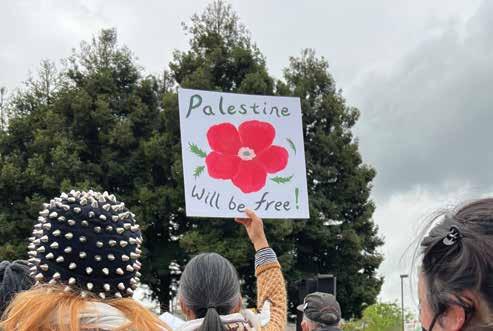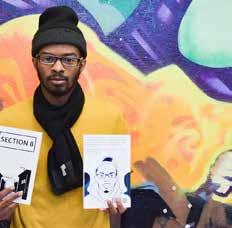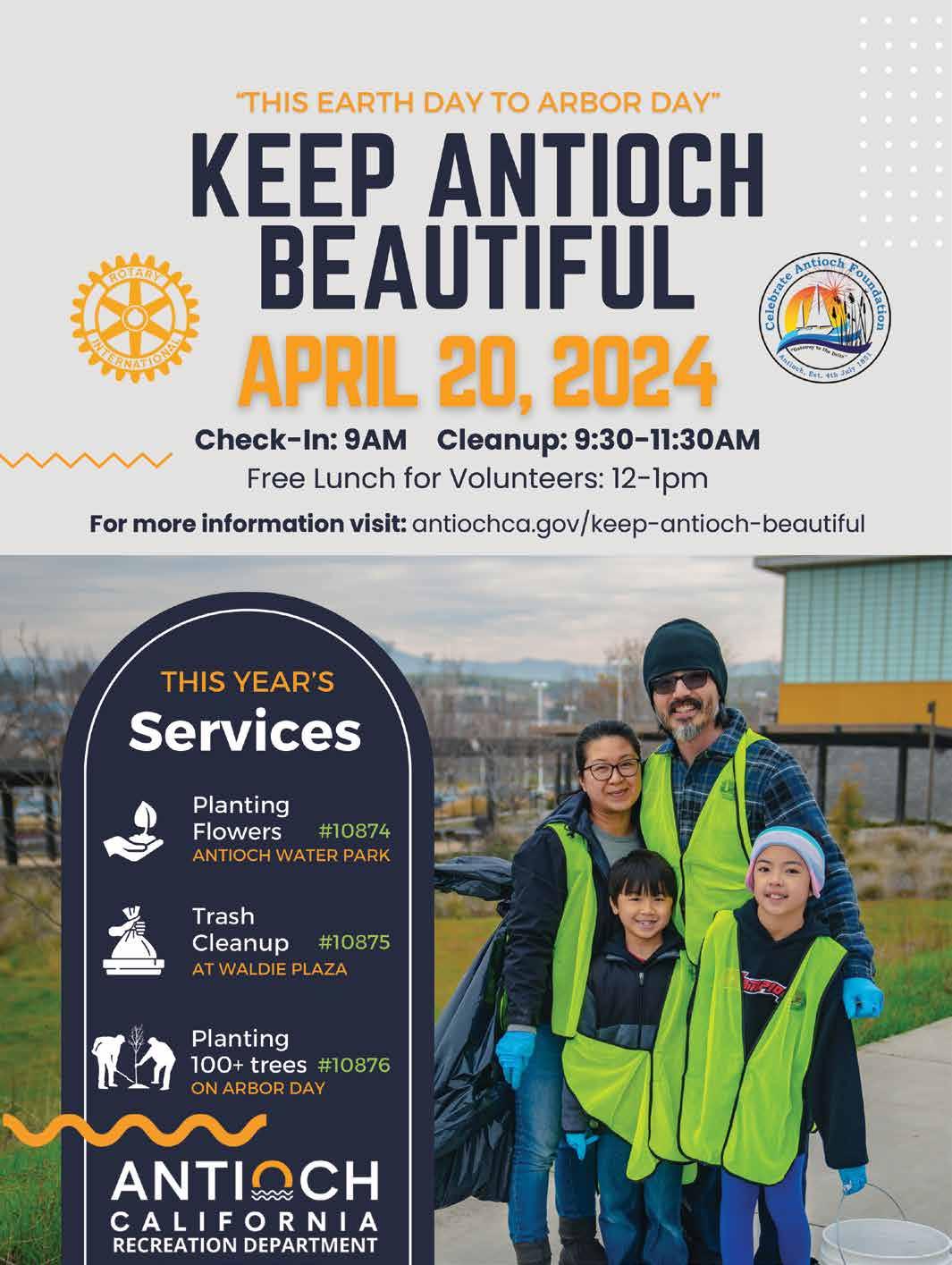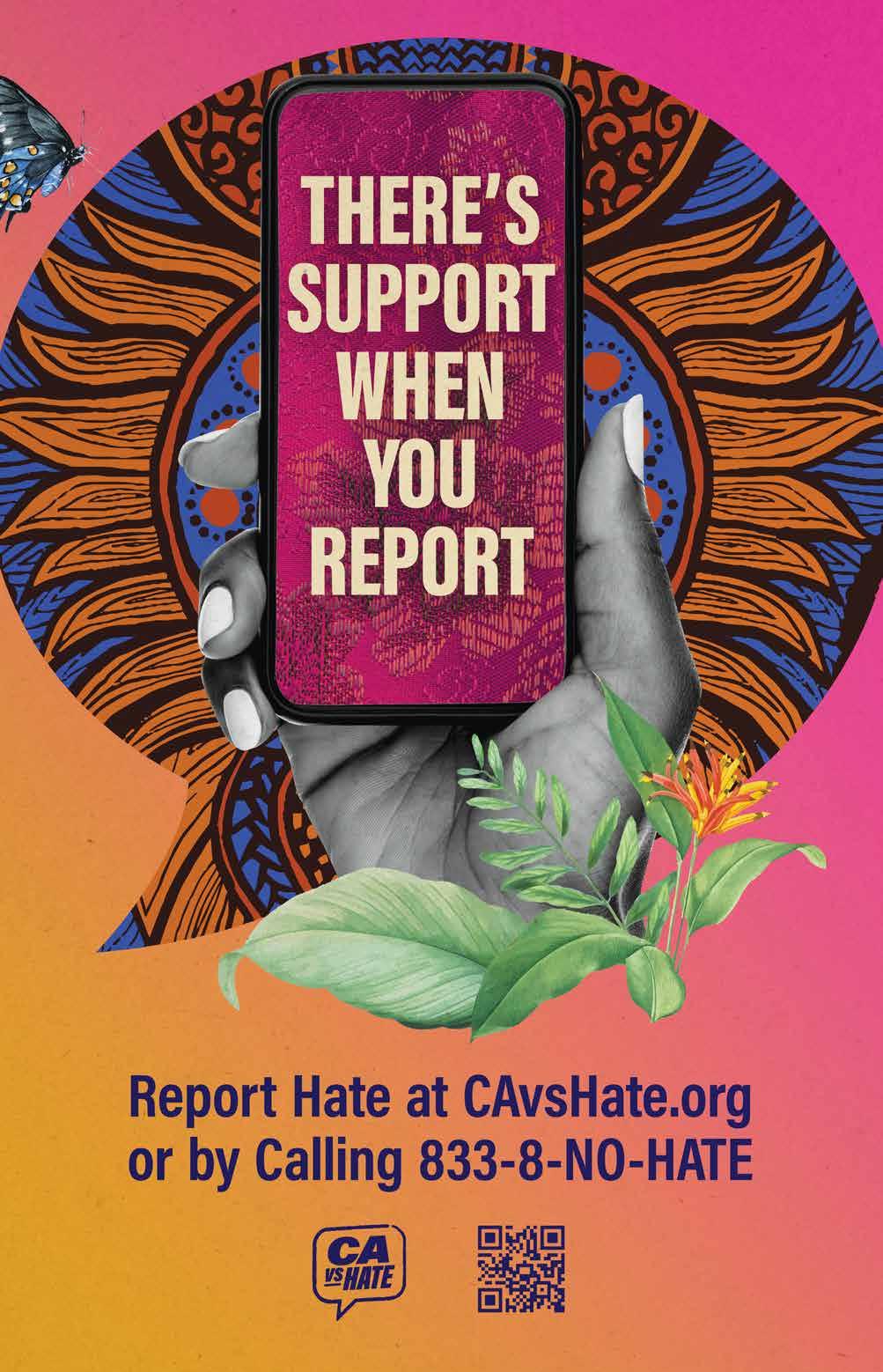
Antioch Teen Accepts Division I Scholarship
See Pg. 6
www.ccpulse.org

Spring


See Pg. 6
www.ccpulse.org

Spring
 BY SAMANTHA KENNEDY
BY SAMANTHA KENNEDY
Just months after appointing its codirectors, Contra Costa’s Office of Racial Equity and Social Justice is dreaming big.
Co-Directors Kendra Carr and Peter Kim shared at the Board of Supervisors retreat Jan. 30 that priority projects for 2024 will focus on increasing equity in the community and county system.
Supervisors Federal Glover and John Gioia led the efforts on the board to create the new office.
Some of the projects include funding holistic wellness resources for African Americans, healing grants, and evaluating current implicit bias training for employees.
Another long-term goal is developing a countywide language equity access plan that grows the department’s capacity to serve those for whom English is not their first language.
The office will also create a 20-member lived experience advisory board that will provide “temperature checks” on equity in the community.
Have questions, comments, or want to get involved?
Contact us at:
info@ccpulse.org
www.ccpulse.org
“All these projects are very aspirational,” Kim said. “We came here to dream big. These are the things we want to do, but it’s all in developmental mode.”
Carr said the priorities and projects identified by ORESJ were informed by community needs. Before Carr and Kim were appointed, several conversations were held regarding equity in the county. Residents voiced a need for increased advocacy and community engagement, addressing how some are harmed by various governmental systems, and decreasing harms experienced.
One 2022 report during those conversations incorporated survey findings and listening sessions conducted with the public that the office hopes will be used to adequately represent community needs on the lived experience advisory board. About 3,300 residents participated in the survey, and “2,600 of them indicated having experienced harms related to inequity and violence,” according to Kim. Most experiences with harm had to do with someone’s race, interactions with police and antiimmigrant attitudes.
Board membership, which will be
The Contra Costa Pulse is a community media project focusing on local and health news coverage in West and East Contra Costa County. The project is supported by STRONG Collaborative Fund.
composed to properly represent harms experienced by residents, will be half district-based and half countywide. Age will be another factor taken into consideration, according to Carr, to ensure there is representation across generations.
District 3 Supervisor Diane Burgis said some community members have shown interest in sitting on the advisory board but did not want to be publicly identified as someone having that lived experience.
“How do we show the community that we have this representation but also give people that [privacy]?” Burgis said.
Kim said that advisory members would have to disclose that they have lived experience to be considered for the position but do not have to publicly discuss that experience if they wish not to.
The Board of Supervisors will approve appointments to the advisory board and provide oversight.
“If we’re serious about improving the conditions for our most vulnerable, most harmed community members and residents, then we need to center equity in everything that we do,” Kim told the
In Pictures: Pittsburg High Hosts Talent Competition Honoring Dr. Martin Luther King
Pulse in an email. “This means that … we are intentional about eliminating racial and socioeconomic barriers so that everyone in Contra Costa, but especially our communities most impacted by inequity and who are hurting at the highest rates, have the resources, services, and information that they need to live full, healthy lives.”
The board approved a $1.26 million budget for the Office of Racial Equity and Social Justice for the 2023-24 year. Of that, $400,000 will be allocated to priority projects.
The office will also look to hire four new employees by the end of the year. Two coordinators, who will focus on language equity and reconciliation, are expected to be hired by July. A data analyst and policy & budget analyst will be hired by October.
Kim said the office is exploring the idea of piloting two small grant programs — one that provides residents and neighborhood groups with micro-grants to support their efforts when responding to crisis and trauma; and another helps emerging, grassroots organizations build capacity. •
 Community
Community


Scan
Publisher
Malcolm Marshall
Editor
Danielle Parenteau-Decker
Contributors
Michael J. Fitzgerald
Juan Cebreiros
Joe Porrello
Samantha Kennedy
Hamza Fahmy
Taylor Barton
Yaslin Rodriguez
Ana Tellez-Witargo
Denis Perez-Bravo
Vernon Whitmore
Sandy Close
Michael J. Fitzgerald
The Contra Costa Pulse is a community media project founded by New America Media, focusing on local and health news coverage in West and East Contra Costa County.
The project is supported by The California Endowment and the STRONG Collaborative Fund.
Have questions, comments, or want to get involved?
Contact The Contra Costa Pulse at info@ccpulse.org www.ccpulse..org
On the 10th anniversary of the Center at Sierra Health Foundation, program leaders highlighted the effectiveness and successes of a care over criminalization philosophy in dealing with substance abuse during an Ethnic Media Services briefing.
Kaying Hang, the president of the center, said during the briefing that among non-elderly state residents, drug overdoses are a leading cause of death.
“And these numbers are expected to increase,” she said. Stats from the Centers for Disease Control and Prevention pointed to approximately 109,000 people dying from a drug overdose in the U.S. in 2022. The year before, California saw close to 10,900 deaths related to drug overdose, according to the state Department of Public Health.
Hang stressed that center programs focus on care and not criminalizing substance abusers. “People who use drugs are not strangers but our neighbors, family members, friends,” she said. “We can give them a second chance. Everyone deserves a second chance.
The executive director of the Central Valley Empowerment Alliance, Mari Perez-Ruiz, told reporters it is constantly battling a misguided notion that Central Valley communities don’t have any future, linked in part to rampant substance abuse.
“Pervasive drug abuse, especially
fentanyl, is dire here,” she said. “Our communities are targeted by the cartels, and sometimes the parents here are using or selling drugs.”
To battle those influences, CVEA opened the Leadership Unity Power Empowerment Center as a safe, drugand gang-free place for young people and their parents. Perez-Ruiz said conversations there revolve around new possibilities for the young people’s lives.
In Inyo and Mono counties, programs offered by the Crossroads Recovery Center and Skoden Harm Reduction Services provide services to treat individuals with substance abuse issues in humane terms, well away from traditional legal/law enforcement approaches.
“Native Americans have some of the highest fatal overdose rates — not just in California but nationwide,” said Arlene Brown, CEO of both programs said. She said the programs are for everyone in need — not just Native Americans.
Native Americans make up 17% of the area population. “Our program is for everyone,” she said. “Our core value is sharing healing with others, and half of those we help are non-Native.”
The indigenized services offered include putting prayer tags on overdose kits, distributing Narcan in the communities, and counseling. The counseling looks at assisting with “spiritual, mental, physical and emotional wellness,” Brown said.
The emphasis, as in other Sierra Center programs, is on treating the entire person. “We already know shaming our
loved ones for substance abuse only pushes them further away,” she said.
In Alameda County, the HIV Education and Prevention Project operates on the philosophy that people in recovery have a wide variety of needs and goals.
Executive Director Braunz Courtney says not everyone they see has sobriety as a goal. But the staff attempts to help with whatever a person needs.
“Our goal is to meet each individual where they are geographically and within their addiction,” Courtney said. “”It’s a spectrum from using drugs more safely to abstaining completely. Some people will never get to a point of sobriety.”
The project hires people who have an understanding of substance abuse and sometimes have gone through recovery themselves. They assess an individual’s needs beyond normal clinic assistance. They offer help with housing, food, hygiene and even social interaction, Courtney said.
The project operates an Oakland-based drop-in clinic in addition to having mobile units that provide counseling, overdose education and syringe exchange, along with HIV and Hepatitis C testing.
“For us, it’s about creating homes wherever people are in need. We’re not here to tell you what to do,” Courtney said. “We’re navigators. Equitable health care means that those who access it tell us what they want, and we tell you how to get there. You’re the expert in your own life.” •
I mmigrant rights advocates expressed concern in a Feb. 12 press conference over a new deportation court that opened that day in Concord.
The court, opened by the U.S. Department of Justice’s Executive Office for Immigration Review, is meant to address the nationwide backlog of immigration cases, which now stands at over 3.3 million, according to the Transactional Records Access Clearinghouse at Syracuse University. But the advocates say that immigrants, many of whom already face the fear of appearing in court without adequate legal resources and not speaking English at all or as their first language, now confront additional uncertainty.
“It’s very important to understand that the purpose of these courts is to deport immigrants,” said Heliodoro Moreno, an immigration attorney with Stand Together Contra Costa, a partnership of several immigration rights organizations and the Contra Costa Public Defenders offices. “It’s meant to do that, to deport as many people as possible.”
According to a 2022 report to Congress, 65% of initial immigration cases heard at EOIR courts resulted in deportation, while only 13% of cases were granted relief from deportation, such as asylum.
According to Rosa Menjivar, the advocacy manager with the Latina Center in Richmond, many people are seeking asylum at the border. They are allowed in the country but must present their case before a judge to remain in the United
States, whether they have an attorney or not.
Unlike criminal defendants, immigrants who cannot afford an attorney are not provided with government-appointed counsel.
“You have to go in there and represent yourself even if you’re a little kid,” Moreno said.
Although most EOIR cases result in deportation, having legal representation can significantly improve the outcome. A Syracuse University data study showed that those with legal representation had a higher chance of having their cases dismissed or receiving relief from deportation compared with those who were unrepresented.
Moreno said the opening of courts like this one have led to fewer immigrants having a lawyer, which, in turn, has led to more being deported.
“Immigrants that have an attorney win their cases over 60% of the time, but when they don’t, that drops down to less than 20%,” he said.
Edwin, a young immigrant identified only by first name due to his immigration status, spoke at the press conference. He came to the United States to escape violence in his home country. A little after Edwin entered the country, his brother was deported. He was worried about his court hearing since he did not have money to hire an attorney. Fortunately, with the help of a teacher, Edwin found STCC, which provided him with the legal support he needed. Edwin asked the crowd and STCC to continue supporting immigrants like him who need legal assistance.
Onetime Antioch poet laureate Jose Cordon, who works with Monument Impact, spoke at the press conference as well.
“Some people don’t understand why others would risk life to come here,” he said before reciting from his poem “Blood Papers,” which speaks to the immigrant experience and dreams. “I have something that many people take for granted, something that makes thousands cross the Rio Grande in the middle of the darkness. Imagine your child in your arms, and you try to escape from all the madness...”
Trying to navigate the legal system can be its own form of madness for migrants as “experts have called these immigration laws a labyrinth,” according to Moreno.
“The county and all of the other local governments…should be providing resources to their communities and constituents to ensure they are getting their due process,” said Maciel Jacques, Centro Legal de La Raza deputy director.
Last year, the Contra Costa Supervisors allocated funding to hire more attorneys within STCC to help with immigration cases. However, more funding is likely needed because the Concord court will hear cases from 10 counties.
The advocates also say more transparency is needed with the case transfers from the San Francisco jurisdiction to Contra Costa.
"EOIR has issued little to no notice of the cases transferred from the San Francisco jurisdiction to Contra Costa, raising significant due process concerns and sparking confusion among community members,” said the California See Court, pg. 6
Inge Auerbacher was in first grade when the Nazis began sending people like her to the concentration camps.
Many children, including most of her friends, and several of her relatives were killed in the Holocaust. Against the odds, she survived.
Auerbacher has since dedicated herself to speaking publicly about the Holocaust. She doesn’t want people to forget or history to repeat itself.
To help children learn what happened, she has long been visiting classrooms. Now, she’s going digital.
With technology companies Meta and StoryFile, Auerbacher is telling her story in an immersive, virtual experience called “Tell Me, Inge.”
“It is like opening a book, and that book becomes alive,” said Auerbacher.
Virtual reality and artificial intelligence simulate a conversation with Auerbacher. Questions users ask are answered with responses she prerecorded, which are accompanied by illustrations. “Tell Me, Inge,” which is available in multiple languages, is designed to be experienced via VR headset but can be accessed on mobile and desktop.
Auerbacher sat down with Meta Director of Public Policy David Tessler and StoryFile CEO Stephen Smith at the Eradicate Hate Global Summit in Pittsburgh on Sept. 27.
Smith good-naturedly called her “the oldest Gen Z’er I know.”
Born in the beginning of the Third Reich era, Auerbacher was delivered in a German village by a Nazi doctor who would later be imprisoned. He “was always good to the Jewish people until, until the bad things happened.”
Auerbacher was 3 on Kristallnacht, or “The Night of the Broken Glass," when most synagogues in Germany and Austria were burnt to the ground.
“We had to hide. They were banging at the door and trying to get in,” she said, referring to her family’s home on Kristallnacht.
Shortly after, Auerbacher’s father — a decorated and disabled WWI veteran — and grandfather were forced into the first concentration camp, Dachau.
“I never even finished my first grade; all the transfers began at that time, and

almost the whole school was sent to the East to be killed,” she said. “Almost all of my friends went to the gas chambers or were shot.”
Auerchacher said her grandmother was shot by Nazis in a Latvian forest and was one of 14 siblings all murdered.
“We were in the same transport, but somehow we got out,” she said. “Otherwise, I would be in a mass grave.”
Nazi leadership forced Jewish people to purchase and sew a yellow Star of David on their clothes; other persecuted groups were made to wear different symbols. Auerbacher tore her “yellow star” off when the Russian army liberated the Jews on May 8, 1945.
“The sign of hate for us,” said Auerbacher, referencing the yellow badge. “And that’s why I wrote my first book, ‘I Am A Star’: I turned that meaning around.”
Before Auerbacher leaves a classroom, she has students chant, “I’m a star.”
Auerbacher emphasized that the Holocaust was less than a century ago and expected by few German residents who thought their homeland was safe.
“How could it happen? But it did… I’m afraid for the future too with things that are going on in the world…It’s a nightmare,” she said. “Could it happen again? I think, yes, in a different way.”
Jewish Federation of Greater Pittsburgh CEO Jeff Finklestein, who introduced the talk, said Nazis murdered most of his family in 1941. He said “Tell Me, Inge” would “make sure the memory of those who were lost can continue on and be a lesson to all of us about what hatred and xenophobia can lead to.”
Smith said internet narratives — especially individual stories — can be powerful in trying to combat hate but said they need to be controlled to be most beneficial instead of causing harm.
“Tell Me, Inge” is an example — “for young people, in particular, who are just getting into that cesspool of data that could actually be quite harmful, and giving them the chance to learn from her, with her, and go really deep,” said Smith.
Meta Vice President of Trust and Safety Policy Neil Potts acknowledged that issues of hate are larger than any one organization or community.
“Whole society problems demand whole society solutions,” he said.
Potts said the virtual conversation could help build a more empathetic future.
“It’s not just about understanding the Holocaust,” he said. “It’s about feeling the weight and significance and understanding why it’s crucial that we
 BY SAMANTHA KENNEDY
BY SAMANTHA KENNEDY
I n front of a Pan-African flag, Antioch swore in the first members of its police oversight commission Feb. 13 as it awaits the outcome of the racist police texting scandal.
“Tonight represents this government taking hold of its city’s instruments and making sure that every department in the city represents the values of this city,” Mayor Lamar Hernandez-Thorpe said. “We’re not going back.”
Seven residents with experience in the justice system, mental health, community organizing and ministry were appointed to terms of up to three years. The shortest appointments will expire in November.
Alicia Dianne Lacey-Ocha, executive director of Love A Life Outreach Ministries, and Devin Williams, a community organizer with Alliance of Californians for Community Empowerment, were appointed to oneyear terms.
Williams is a regular fixture at council meetings, often advocating for renter protections with ACCE. He was one of the organizers who spoke in support of an anti-harassment ordinance for tenants that passed in July.
Porsche Taylor, executive director of a faith-based rehabilitation program, and Leslie May, a therapist and activist, were appointed to two-year terms.
May was recommended for the commission by council member Tamisha Torres-Walker, who said the youth involved in the process were impressed with her background in mental health and felt it was needed on this commission.
Mahogany Spears, who was previously a probation officer for the counties of Alameda and San Francisco; Treva Haden, an analyst with Oakland Police Department’s Office of Internal Accountability; and Harry Thurston, a former member of Antioch’s Crime Prevention Commission, were appointed to three-year terms.
Thurston was among the first to participate in the Antioch Police Department Citizens Academy in 2015, which taught residents how the department trains and investigates, and has been vocal about the city’s need for a police oversight commission for years.
The commission advises city staff, including the City Council, on public safety matters and increases communication between the police department and the community.
After the commission was created in 2022, residents could apply to be on the commission through the beginning of 2023. Appointees went through an interview process involving council members and local youth before being recommended by a member of the council.
Each appointment drew loud applause from the crowd that sometimes drowned out the council’s decisions.
Decisions that, with the exception of absences by council member Michael Barbanica and Mayor Pro Tem Monica Wilson, were unanimous.
Residents, some who have been impacted by the actions of the Antioch Police Department, further shared that
 STORY AND PHOTOS • TAYLOR BARTON
STORY AND PHOTOS • TAYLOR BARTON
Hundreds of protestors, including Mayor Eduardo Martinez, rallied outside Chevron’s Richmond refinery Feb. 3 to call the corporation out for its work with Israel and demand a permanent cease-fire in Gaza.
Organizers expressed anger at the effects the local refinery has had on Richmond residents and said they felt solidarity with those in Gaza who they say are suffering at the hands of the same corporation.
The rally marks the beginning of a local call to boycott and divest from Chevron for its role in “fueling the ongoing occupation of Palestine,” said the Chevron Out of Palestine coalition in a press release. They point to Chevron’s work with the Tamar and Leviathan gas fields in disputed eastern Mediterranean waters.
“Environmental racism is a tactic of colonial oppression and economic warfare,” said an organizer from the Palestinian Feminist Collective onstage at the event who asked to remain unnamed. “It is equally environmental racism when Chevron pollutes the air in Richmond, harming thousands for profit.”
Dr. Jess Ghannam, an organizer from Health Care Workers for Palestine, agreed: “In addition to the genocide, there’s environmental terrorism going on in Gaza right now and throughout Palestine.”
He’s not the only one who thinks so. At COP28, the U.N.’s annual climate summit in November, activists and global leaders reportedly raised concerns that Gaza could become an “environmental catastrophe.”
“Air, water and land are being destroyed as we speak,” Ghannam said. “Now, does that sound familiar to anybody who lives in Richmond?”
Murmurs of “Yes” rolled through the crowd.
Air pollution is a regular concern for many Richmonders. According to the UCSF’s Respiratory Health Lab, “the prevalence of asthma in California is approximately 13%. In Richmond, CA, it approaches

25%. In addition, asthma attack rates are almost double the state rate.”
The Bay Area Air Quality Management District also lists Richmond as an overburdened community, which it defines as “especially vulnerable” to air pollution between location, sensitivity and socioeconomic factors linked to poor healthcare.
“Throughout the years, I have seen the Richmond Chevron refinery explode and send 15,000 residents to the hospitals, spill oil into our San Pablo Bay and flare constantly,” said Lily Saefong, a youth organizer with the Asian Pacific Environmental Network.
Chevron Out of Palestine is a self-described coalition of East Bay residents, environmental justice advocates, and over 40 local grassroots organizations. The protestors were a diverse group, with grandparents alongside toddlers and activists from far-ranging causes. The rally included poetry, songs, prayers and the group painting of a street mural that read “Ceasefire Now. Chevron stop fueling genocide.” At one point, young kids from East Bay Families 4 Ceasefire took the mic to lead a squeaky but passionate call and response.
“There is no Palestinian freedom without an end to systemic gender, sexual and colonial violence,” said the Palestinian Feminist Collective organizer. “And there is no liberation without confronting systemic racism against Black women and Palestinian women.”
According to Chevron’s website, the corporation began operations in the region after merging with Noble Energy, Inc., another U.S.-owned company, in 2020. The Tamar gas reservoir provides 70% of Israel’s electricity needs, the company says.
What does this have to do with Gaza? “The Chevron corporation supplies Israel’s genocide with light and power,” organizers said.
Some critics question the effectiveness of demonstrations like this, citing the unlikeliness that a major corporation like Chevron would shut down costly operations because of a rally in California.
The Leviathan oil field alone produced $2.5 billion in revenue last year, the New York Times reported.
But demonstrators say that’s not the point.
“I don’t think a single action is going to help them grow a conscience, but I think the public pressure like BDS is working,” said Sheela Ivlev, a local occupational therapist who shuttled participants back and forth to the BART station.
She’s referring to Boycott, Divest, and Sanctions, a national movement that aims to “end international support for Israel’s oppression of Palestinians and pressure Israel to comply with international law.”
“Just naming, shaming and providing people with education is significant,” she said. “So just your attention or people showing up or educating themselves, that exponentially grows.”
Mayor Martinez and others onstage emphasized the difference between Chevron’s workers and those in charge of the corporation.
“I know the workers are listening. And I know the workers would be out here with us if it didn’t impact their livelihood,” Martinez said in an interview after his speech.
According to a report it issued in 2021, Chevron’s Richmond location employs some 3,000 workers and contractors, and is the largest energy producer in the Bay Area.
When asked whether getting rid of Richmond’s refinery would harm jobs for Richmonders, Martinez immediately said, “That’s bull—.”
“Most of the people who work in Chevron don’t even live in Richmond,” he said. “There would be a lot of environmental work in cleaning up the mess that they’ve created. And if we do it wisely, we can have a transition in which jobs are created as jobs are being dismantled.”
Chevron did not return any calls or emails from the Contra Costa Pulse for this story. •






An Antioch High softball star will be taking her talents to Weber State University in the fall. In December, Apollonia “Apple” Maldonado accepted a full-ride scholarship offer, committing to the Division I school in Ogden, Utah.
“It means just about everything to me and my family,” the 17-year-old Maldonado said. “They’ve put so much time and thousands upon thousands of dollars into me. To know they don’t have to pay anything, necessarily, and for me to play the sport I love, it really hit hard.”.
Maldonado said her love for the sport came at 4 years old when her parents tried putting her in sports to keep her busy. Ultimately, her love for the game of softball stems from her parents. Maldonado said her father used to coach softball and her mother used to play.
“What I love about softball is the diversity of the sport and how everyone can be included no matter what your skill set is. It’s truly a game of teamwork as well, and I love that I’m able to play the game with people I care about, which makes the teamwork easy.”
Her immediate family have been among Maldonado’s biggest beacons of support, along with her coaches. She said they have “given me confidence” throughout her career.
That career has flourished, growing from a game she just enjoyed playing to something that will pay her way through college. Her hard work behind the scenes is what got her to this point.
“My work ethic has really put me here,” Maldonado said. “Evenings are always taken with homework and practice. When it comes to high school and summer travel-ball seasons, I don’t have time, especially with maintaining straight A’s.”
As a result, she said, she had to learn time management from a young age. “However even then, there were still a lot of sacrifices I had to make like late nights and early mornings doing homework, or getting some of my work done in car rides on my way to practice.”
Continued from page 3
praise during public comment.
“She had to stop me to help me rethink and reframe myself into healing,” Kathryn Wade, the mother of Malad Baldwin, who was beaten by Antioch officers, said of May. “I sat there crying, ‘but me, but the police, but it hurts,’ . . . and you helped me find my healing through God, through recovery.”
Frank Sterling, a Native American KPFA reporter who was allegedly attacked by officers at a protest, said the possibility of an oversight commission has been there for a long time. Sterling said that when he asked for a police oversight commission after his attack, “there was crickets,” and the crowd instead cheered on those opposing the commission.
“I’m very excited we have such qualified people stepping up,” he said.
However, former council member and police officer Ralph Hernandez was critical of appointees whose qualifications he said “fell short” and had openly criticized the department. Most of what the commission is tasked with doing, he said, can be handled by city staff and department administration.
Ogorchock said after Hernandez’s comments that she believed the appointees were open-minded and wouldn’t allow any biases they may or may not have cloud their judgment.
“You will do the public’s work, just as this council does,” Ogorchock said. “I hope and pray, and I believe in my heart, that this is how this commission is going to act.” •

Over the past two seasons, her effort has begun to show results on the field. Maldonado has led her team in batting average and on-base percentage in each of the past two seasons and won Most Valuable Player of the Bay Valley Athletic League for the 2023 season.
“It really means a lot,” Maldonado said. “It goes to show my efforts have not been put to waste. I’ve always wanted to be at the top.”
The Antioch High senior calls her high school career thus far “pretty successful” as Antioch has qualified for the playoffs and finished with a .500 record or better in each of the past two seasons. She added that it’s really taught her how to be humble and the team to work for their recognition because “we don’t see many people going Division 1 in their sport too often.”
Not only a good hitter at the plate, Maldonado has shown versatility on defense. She has played first base, third and catcher as a freshman, and shortstop as a sophomore and junior, making First Team All League each year.
Now, Maldonado wants to be a leader in her final season with the Panthers before she goes off to college next year.
The Panthers have lost many of their recent team
Continued from page 2
Collaborative for Immigrant Justice in a statement.
Immigrant rights advocates said to verify whether their cases have been transferred, people should first identify their case’s A number, or alien registration number. It is a unique identifier essential for tracking case transfers. Then, they can inquire about the status of their case by calling the EOIR hotline at 1-800-898-7180 or visiting the following website: https://acis. eoir.justice.gov/en/.
Later this year, people will have an opportunity to meet with an immigration attorney for free.
The Latina Center and Stand Together Contra Costa will host a free immigration clinic Apr. 15, from 9:30 a.m. to 2 p.m., at the Latina Center located at 3701 Barrett Ave., Richmond, CA 94805. The consultations will be first come, first served.
Stand Together Contra Costa has information on additional Immigration clinics on its Facebook page: https://www.facebook.com/ StandTogetherContraCosta. •

Continued from page 3
never, ever, ever forget.”
leaders with nine players from the 2023 roster having graduated. So Maldonado said, “this season is going to be harder,” but she is ready to step up and help take their place this upcoming season.
“My goal right now is to help the people around,” Maldonado said. “I want to support them and benefit the team as a whole. This roster isn’t a wow factor, but I really want to contribute to our team and our program because we’re still competing.”
Also leading the way will, of course, be the team’s coaches.
“I’ve only seen a glimpse of the struggles they go through in order to give us the opportunity to stand out and play the game we love,” Maldonado said.
She credits them with more than just making her a better player.
“I know for a fact I wouldn’t be here without them and they are not only important people in my life, but family to me and my own family as well,” Maldonado said. “They have helped me grow as a player by teaching me life skills and helping me grow first as a strong individual in today’s society. They’ve taught me that the most important part of the game comes from the lessons you learn in life.” •
Unlike Auerbacher, most Jewish children did not survive the Holocaust. As many as 1.5 million of the 1.6 million living in what was Nazi territory were slaughtered, and about 80 years later, few are left to tell the tale firsthand.
“As the brave souls who lived through these times leave us, there’s a rising danger that these events may fade into mere footnotes in history,” said Potts, “and projects like ‘Tell Me, Inge’ make sure these stories stay alive.”
Auerbacher made it her life’s mission to educate people on the horrors of the Holocaust, and this VR experience will help her story outlive her.
“I always said, I want to be 100 years old, maybe 1,000; this gives me the opportunity,” she said.
Smith spoke to the impact of the project and its implications.
“What I think is so fascinating about this information age is that if we can channel that world, it’s such a powerful tool in our armory against hate,” he said. “And it doesn’t just apply to the Holocaust; this could be all our stories.”
This resource is supported in whole or in part by funding provided by the State of California, administered by the California State Library in partnership with the California Department of Social Services and the California Commission on Asian and Pacific Islander American Affairs as part of the Stop the Hate program. To report a hate incident or hate crime and get support, go to cavshate.org. •



The preservation of identity came to life one evening in Pittsburg as an art form known as folklórico weaved together centuries of culture and tradition through dance.
Folklórico — a collective term for types of dances from different regions of Mexico that combine elements of ballet and local folk culture — was on stage March 1 at Willow Cove Elementary School.
The vibrant rhythm of music and dance echoed through an auditorium filled with more than 400 people paying to attend the first Folklórico Extravaganza hosted by Pittsburg High School Folklórico Group.
“It is all about culture,” said Tezol Tlahui Gonzalez, a Pittsburg High senior and folklórico dancer. “To be able to come together as a group and as a family, and celebrate, not just the dance but the music all at once, has been very beautiful to me.”
Alongside her peers that night, Gonzalez ran the technical side of the show like slideshows, TV graphics and the sound system.
“To be able to create such a big event like this takes a lot of planning, so it creates a lot of skills for us youth,” Gonzalez said.
With all of the chairs filled in Willow Cove’s auditorium, those who couldn’t find a seat sat on the floor down front or along the sides. Toward the back, cafeteria tables were filled as well and the back row lined with people enjoying Mexican treats like shaved ice drinks and street corn sold by a vendor.
A roster of folklórico dancers and singers from different disciplines and regions of origin took the stage from 7 to 9 p.m.
After an intermission midway through, professional dancer and instructor Janitzia Rodriguez, a 40-yearold Pittsburg High alumna, recalled the rich history of folklórico in Pittsburg. This included her own family’s involvement.
Since the 1940s, a dedicated lineage of individuals has safeguarded the heart of folklórico in Pittsburg,

Rodriguez said.
Among the trailblazers she recalled was Jesus Perez — her grandfather — who arrived in Pittsburg in 1920 to labor at the steel mill. Alongside his wife, Perez was among the founding families of a local Sociedad Guadalupana in the 1940s.
Simultaneously, Carmen Gonzalez led the Sociedad Guadalupana and nurtured the tradition locally from the '40s to the '60s, offering classes from her home to the next generation, including Rodriguez's aunts and uncles.
Rosadelia Detwiler, a teacher at Central Junior High School, created a Folklórico Mexica group during the 1970s Chicano Movement and spearheaded a La Raza Club at the school.
In the '70s, Nick Vazquez, a member of Folklórico Mexica, pursued studies at UCLA. Upon his return, he introduced Los Angeles-acquired Folklorico to Pittsburg, helming Folklórico Mexica from 1975 to 1978. The group would perform at vibrant afternoon community parties known as "Tardeadas” that could last up to eight hours.
In subsequent years, Ernestina Ruiz and Angel Valencia sustained the Folklórico Mexica tradition, laying the groundwork for Ruben Rodriguez's leadership in creating the ballet folklórico group Olin De Contra Costa. From 1986 to 2016, Rodriguez served as a dance instructor, and he performed for over 50 years.
“He (Ruben) was the person who really helped sharpen my skills in folklorico,” Janitzia said.


Further driving Folklorico's prominence in contemporary times is Eugenia Rodriguez, who established the first official folklórico group at Pittsburg High School in 2012, according to Janitzia.
Today, Eugenia has championed more teachers at the high school, including Janitzia, who is a drop-in instructor and Sagrario Ibarra, a new ballet folklórico instructor at Pittsburg High and the founder of the "Asi Se Siente Mexico" group.
“This is just the beginning," Tezol said, stating the plan and sentiment of many of the students is to make the event an annual tradition.
With plans for future editions and dedicated students and alumni, Pittsburg High School is poised to continue the legacy of preserving folklórico through dance and music for years to come.
“You can see the countless hours of preparations,” 51-year-old Concord resident Luisa Carrera said. “I am blown away by the musicians, the violinists, the vocalists. Everything.”
Carrera came to support her 8-year-old niece Isabel who is part of the “Asi Se Siente Mexico” group.
This was the first folklórico festival Carrera has been to. And she found it warming how youth were able to connect with their roots through their teachers and art.
She said that organic connection is special.
“It is special that these kids can connect their roots with the community here,” she said. “You can see the generations coming together.” •



competition won third place for her spoken word, earning her $100.
“Why must our brothers and sisters holler to be heard?
A talent competition honoring Dr. Martin Luther King took place Jan. 11 at Pittsburg High’s Little Theater. It was open to all students in the Pittsburg Unified School District.
Six contestants took the microphone, with five giving spoken-word performances and one singing a song.
Souljahs, a group that joins forces with local schools to educate the community through initiatives like its literacy program, hosted the show.
Performers all related their spoken words to King.
“Dr. King may have helped us gain the lives we live today, but we need to continue to fight to keep it,” said Jenesis Dejesus, who won $350 for first place. “To create a just and equal society that Dr. King dreamed and advocated for, we need to have our own dream.”
The eldest of three Lawson sisters performing in the
Rosa Parks when she refused to give up her seat, George Floyd when he said he could not breathe. Why must we fight so hard — be so strong — to prove ourselves to a country that we built with our own two hands and feet?” said Juwel Lawson in her performance.
Lawson — who is also in the final stages of writing a book — said she wants to participate in more similar events after seeing what it was like.
“I feel amazing…I was kind of nervous, very nervous, but it felt good,” she said.
Antwan Saece said he is familiar with comparable competitions through the Pittsburg Prodigies Poetry Club at Pittsburg High but had had a small hiatus from performing before Jan. 11.
“I forgot how thrilling it is just to get up there and

speak your mind,” he said.
Saece said he was preparing for the upcoming Youth Speaks teen poetry slam in San Francisco.
All participants were awarded at least $75 for performing in the event.
“There are no losers,” Souljahs member Clexton Ward said. “This shows them, hey, we’re here, and don’t think you did this for nothing because you’re touching our hearts with what you’re giving us.”
Ward said it was extremely difficult for him and the four other judges to decide on the order of winners because they all put on a great show.
“It was crazy back there… we were all conflicting,” he said.
All of the participants were set to be back at Pittsburg High on Jan. 15 for a repeat performance at the 23rd annual MLK Day festivities hosted by Souljahs that began with a rally at City Hall and a march. •







This past holiday season, the “Tunnels of Joy” were on display for the eighth year in Brentwood, this time to raise money for a high school student with cancer.
Husband and wife Mostafa and Yvette Gardizi first put up the tunnels on La Costa Drive, starting an annual tradition for many families that has since expanded. She said the event has become bigger as the years went on.
“It’s really grown organically,” Yvette Gardizi said. “It’s become a tradition for a lot of families to come see. At first, it was just local, but now, people from all over the Bay Area come to see the tunnels. It’s a great place to come. It’s festive. The kids love it, and it’s a great place to start a family tradition.”
In response to the growth, Yvette said she’s started to hire people in the past three years to help control traffic in the neighborhood, as well as to help pick up trash left by visitors.
In past years, local businesses have not gotten too involved with the “Tunnels of Joy” fundraising. However, this year, local food trucks were brought in to feed visitors and help raise money by donating a portion of their sales. This was also the first year performers were invited from local middle and high schools to add entertainment to the decorations.
“It truly is just grassroots and community-oriented,” Yvette said. “We have kids with special needs that come, and they get a really great reaction when they see all the decorations.”
The name for the tunnels as well as the motivation behind the event comes from a former neighbor of

One couple started a holiday tradition in Brentwood with “Tunnels of Joy” to raise money for a member of the community who has cancer and their family. In its eighth year, an estimated 100 families participated in their creation.
the Gardizis named Joy, who died of breast cancer in 2009. Gardizi said she and neighbors who help with the “Tunnels of Joy” call themselves “the Joy makers” in her honor.
During the first couple of years, the Gardizis slowly reached out to neighbors to ask them to also put up tunnels during the holiday season. She said she believes 100 homes from the neighborhood now participate in the “Tunnels of Joy.”
“I call it positive peer pressure,” Yvette said. “Once you see your neighbor put it up, then you feel inclined to do so also.”
Yvette said her family would always visit a specific neighborhood during the holidays while she was growing up in New Orleans, and she wanted to start something similar in Brentwood.
Since its debut, the “Tunnels of Joy” have been raising
money for people in the Brentwood area. Fundraising during the start consisted of mostly bake sales, selling hot chocolates and a donations box, according to Yvette. The goal was to give the money to a family with someone who had cancer.
In recent years, they’ve focused on raising money for children who have cancer, according to Yvette. This year, Heritage High School senior Jeremiah Jones, who has been diagnosed with bone cancer, was announced as the pediatric cancer patient that this year’s “Tunnels of Joy” donations would go toward.
While the event started very small the first few years, Yvette said she believes the event will continue to see an uptick in community interest during the holiday season.
“Everybody needs a little bit of Joy in the holidays,” she said. •
The San Pablo City Council on Feb. 20 commemorated the naming of McNeil Park in honor of Leonard R. McNeil, a 30-year public servant who died five years ago.
McNeil Park was the top name recommended by the Community Services Standing Committee from a list of six nominations across three categories: historic names; places and features; and individuals, groups or organizations.
“We are here representing family and friends who are in full support of naming this amazing open space after our dad,” said Carmen McNeil, joined by her brother,
Yusef McNeil. “His dedication to the city just flooded. It’s so amazing to think about all the ways — the blood, the sweat, the tears, the dedication to the city of San Pablo.”
McNeil was first elected to San Pablo City Council in 1988 and became the city’s first Black mayor in 1992. He is an alum of Richmond High, started the first Black Student Union at CSU Fresno, and was drafted by the Philadelphia Eagles in 1968.
He earned a bachelor’s degree in government at Cal State Sacramento and — at the age of 66 — a master’s in political science at SFSU. He was also nominated for the Western Association of Graduate Schools’ Distinguished Master’s Thesis Award for a work that “explored the possibilities and challenges of African-Americans and Latinos coalescing for political and social change,” according to his obituary by the Black Alliance for Just Immigration, which he co-founded. McNeil was a distinguished professor of political science at Contra Costa College as well and earned a vocational education credential from UC Berkeley.
Among the other four speakers at the Feb. 20 meeting was Genoveva Calloway, a colleague of McNeil’s on the City Council from 2004 to 2012.
“San Pablo will be adding to the history of San Pablo in honoring his legacy,” said Calloway, who was the first Latina mayor of San Pablo. “I was inspired by his
commitment to the community, his leadership, and his mentorship.”
Both council members worked together to build collaboration between the council and the school district. They created opportunities for youth services including reviving the youth commission, expanding the police department’s youth and education services, and developing a truancy strategy for schools.
Calloway said that McNeil “provided the leadership” on the council to make Helms Middle a full-service community school. Together, they were able to make six elementary campuses into full-service community schools as well: Montalvin Manor, Dover, Edward M. Downer, Tara Hills, Lake and Bayview.
Additionally, Calloway and Mayor Patricia Ponce said McNeil worked to keep Lake Elementary open when the district was scheduled to close it.
“It was an honor to know Leonard. Thanks to him, there are over 400 little people that still have their school,” Ponce said. “Not once but twice, their school was saved and now is currently being reconstructed. Personally, I will forever be grateful.”
There were over 20 written submissions in support of the naming of McNeil Park.
San Pablo City Council meets every first and third Monday of each month. •
 STORY AND PHOTOS BY JOE PORRELLO
STORY AND PHOTOS BY JOE PORRELLO
The self-titled “MEGAN MARCH” art installation premiered on Feb. 16 in San Pablo, exclusively featuring the work of one local artist.
Berkeley native and El Sobrante resident Megan March opened the doors to her first art show featuring ceramics, paintings and drawings in the Eddie Rhodes Art Gallery at Contra Costa College.
In her own words, March’s work takes inspiration from the underground vibrations of the Bay, drawing from gender politics and sexual identity as well as the ethereal nature of crossing boundaries beyond the living and expected.
Guests saw thematically linked work that is part of two installations largely making up the show: “Mother of Pearl” and “Spectral Echoes.” The former looks at topics of birth and the strain between the perception of a calm synthetic surface of classical form and the organic, magical landscape beneath, according to March, while
the latter illustrates ways to connect with those who have passed on to realms beyond our waking life.
“It’s really exciting. I’ve been looking forward to it for a really long time,” she said. “It’s great to see it installed and also get to be in the room with other people experiencing it for themselves… I get to re-experience the art through their perspectives.”
Though it was March’s first show as a visual artist, she is well-seasoned in another kind of show. March and her husband, John Mink, have been performing punk rock all over the Bay Area and beyond since 2008 in their band, Street Eaters.
The two mediums go hand-in-hand, says March.
“Even as a musician, I was making art for my band,” she said. “I think the art aesthetic for music is also really important; it’s the whole encompassing experience.” Minoring in studio art and majoring in music at what was then called Mills College in Oakland, March would go on to work as a sound engineer. When musical performances and recording sessions came to a halt in

2020 during the COVID-19 pandemic, she shifted her focus back to visual art.
“I had some time to really think about things, and it made me realize that this is something I really want to pursue… I had unfinished business,” March said.
Having the opening ceremony come to fruition was no easy task.
“It was really hard,” said March. “I have a 4-year-old that was a 1-year-old when I made this decision.” For other local artists aspiring to one day have their own shows and everyone with goals of any kind, March says it’s all within oneself to make it happen.
“When you decide you want to do something, you have to get over your imposter syndrome and just do it,” she said. “You have to cover all of your bases; don’t think someone’s going to do it for you.”
March says she will continue creating sculptures, painting and drawings. Her exhibit at CCC remained open to the public until March 12. •

Cornbread, anyone?
An often relatively low-key shopping center sandwiched between San Pablo Avenue and Interstate 80 was anything but on Feb. 24.
Sharetea Hercules — part of an international bubble tea chain — played host to a meet-and-greet with current Golden State Warriors television color commentator and former team member Kelenna Azubuike for the launch of his new product: Kelenna’s Famous Gourmet Cornbread.
Visitors began lining up on the sidewalk in front of the store an hour before the festivities began. By the time doors opened, people were queued up well beyond the stanchions.
“We’re really excited; this is just unbelievable,” said store co-owner Jeff Todd.
Opening just over five years ago, Sharetea Hercules celebrated its anniversary in December.
Todd runs the business with his wife, Bernadette, who grew up in the Hercules area and has family connections with the Azubuikes.
“We’re very blessed and fortunate; selecting us to launch their business is pretty special,” she said. “Sharetea and cornbread go together really well because we have milk teas, slushies, and hot teas… it’s a good pairing.”
Azubuike noted his mutual happiness with the event and its location.
“To be able to launch here with family — it just felt right,” he said.
Scheduled to end the meet-and-greet at 1 p.m., Azubuike stayed well after until every last fan got to see him. Though not all guests got their hands on Kelenna’s cov-
I was 14 when I first heard about A.I. in a school setting. All around my school, the topic of ChatGPT was spreading among students.
Now, I’m 16, and I have only used ChatGPT one time: to find essay prompts about a few books for English class. It asked me to sign up to use it, which I was a little wary about, but I figured if most of my classmates were using it and nobody mentioned anything about a virus, it would be fine. And it was.
Many students across the country are using ChatGPT — much more than I am. According to a recent Pew Research Center survey, nearly one in five teens who have heard of ChatGPT say they have used it for help with their schoolwork.
While I haven’t used ChatGPT much, I have had other encounters with A.I.
SnapChat A.I., which came out in 2023, has been a source of entertainment for me. When it first came out, I was curious about what it was. I have “talked” to SnapChat A.I. to test it out and ask it questions. I thought it was pretty cool. I asked it for advice with friends, told it stories about my experiences, and went to it as someone to talk to when I was feeling sad and didn’t want to put my feelings on someone else.
It could generate responses to anything I asked within seconds. If I asked it what its favorite color was, it would

“It’s a family event,” said Sharetea
whom are store employees — including
eted Famous Gourmet Cornbread, as it sold out within two hours.
Hercules City Council member and former Mayor Alex Walker-Griffin said the event lived up to his expectations and provided a positive impact on the city.
“As someone who grew up here and grew up a lifelong Warriors fan — and even played for the Junior Warriors — this is absolutely exciting, not just for me but for our residents,” he said. “It’s really bringing a lot of brand to the city and a lot of recognition that usually this suburban area doesn’t get.”
Part of that acknowledgement came from the Warriors television broadcast mentioning the product launch in both of their previous games, with thousands of viewers watching.
Anyone who purchased the moist and fluffy delicacy or a product T-shirt was able to get an autograph from Azubuike, as well as take a picture and chat with him and his wife, Rona — the brains behind the operation.
“My wife has always been a cornbread connoisseur and she never liked the texture… she knew she could make it better,” said Azubuike. “It sticks, it’s not too breakable, and it’s delicious.”
Rona made him the dish on one of their first dates.
“I was like, ‘Oh, my goodness. This is the best cornbread I’ve ever had. What did you put in this thing?’ “ he said.
choose one — and pick the same one every single time. It was amazing and scary all at once.
Though I have personally experienced benefits using A.I., there have also been disadvantages that come with it. For example, in my English class, we have in-class writings about every two weeks or so, possibly more. My teacher has told us that this is specifically because of the use of A.I. The English department does not trust us students to not use A.I. to write our papers and essays.
The two essays we have to write outside of class throughout the entire 2023-24 school year are graded harder than our in-class papers because we have more time to work on them. For me, in-class writings are a lot harder than the outside of class essays. I am a slow worker, so creating a four to five paragraph essay in the span of an hour is not easy. My life has been negatively impacted by A.I. in this way.
But maybe that’s just me. I wanted to know how some other people in my generation use A.I. and how they feel about it. So I talked to four other students in my grade to get their thoughts.
Sean Abello, 16, said that the first time he heard about A.I. was during freshman year of high school when a friend told him about ChatGPT.
Sean said he has used A.I. to find good boba places and that ChatGPT has “made finding sources a lot easier for research papers.” But he is also afraid of the negative effects of AI.
“There has been a big risk in [impersonating people],” he said. A.I. could “risk a lot of jobs and ruin many peoples’ lives because there’s been a lot of [fake images] on the internet.”
Sixteen-year-old Pamela Jones said that the first time she heard about A.I. was the beginning of freshman year. She uses it to make study guides for quizzes and tests.
“It helps make studying a bit easier,” she said, “and that cuts down a lot of the time that it would usually take to make a study guide or study.”
Pamela said whether A.I. is good or bad depends on how you use it.
Soon thereafter, word spread about the snack.
“We served it to the Warriors players and my co-workers and everybody kept saying, ‘You guys gotta sell this’,” Azubuike said.
And it’s not just your average run of the mill cornbread, as the current flavors are jalapeño, caramel, blueberry white chocolate, and ube salted egg.
“That’s another thing that kind of differentiates us,” said Azubuike.
He noted the brand plans to release additional renditions of the product.
“We’ve got like 50 more flavors we’re going to end up doing,” Azubuike said.
Azubuike says they want to get Kelenna’s Famous Cornbread into more Sharetea locations eventually, and that multiple locations have inquired about adding the product. But with a small team, he wants to first make sure they can meet demands before over-promising.
“We’ll work our way to doing more days and making sure we share this with the world,” he said. “We’re a small business and we’re just having a good time with it.”
Updates on future product locations can be found on the brand’s Instagram page. Currently, Kelenna’s Famous Gourmet Cornbread will be available every Saturday at ShareTea Hercules moving forward; it is open every day 11 a.m. — 9 p.m. at 3700 San Pablo Ave., Ste. 2. •
A.I. is, “a really good tool if you use it the right way,” she said. “But if you abuse it, it could become a weapon and it wouldn’t benefit you as much as it could. So if you use it with good intentions, it should be fine.”
Teddy Bell, 16, said he first heard about A.I. when it came out on SnapChat and through “social media posts as well, like advertisements for ChatGPT.” He has used A.I. to generate ideas, write paragraphs, and find information.
“[A.I.] has definitely made life a lot easier because now I don’t have to research or look up as much,” he said. “I can get an A.I. to give me a basic understanding of something, and then I can also use it to help me generate ideas for essays and give me main topics.”
Teddy likes A.I. but also feels that it is “kind of scary.”
He said he thinks “it’s going to make people a lot more lazy and a lot less smart, and it’s unfair because it evens out the playing field — like a [dumb] person can be the same as a smart person now.”
Kaley Chin,16, said that the first time she heard about A.I. was in the fifth grade. She has asked an A.I. questions she had about the world and used it as a source of entertainment.
She also uses it for classes — when she has permission — and says it sometimes makes research easier.
“A.I., is good,” Kaley said. “It may be bad, but like the majority [of it] is good.”
Like my classmates, I see pros and cons to A.I. I think it can benefit us teenagers by easing our workloads and helping us study and find resources. And it entertains us too. But we don’t know what impact it will have on us or the future.
Personally, I am afraid of what it could potentially bring. I don’t think that it is dangerous to our physical health, but I think that it could definitely make people lose their jobs and therefore be dangerous to peoples’ mental health. Whatever the future impacts of A.I. may be, for teenagers, it is making things a lot easier, and for now, that seems good enough. •
Two refineries in Contra Costa County have agreed to end lawsuits against the Bay Area Air Quality Management District in a settlement that includes millions of dollars in payouts from Chevron.
BAAQMD officials announced Feb. 13 that they have reached separate agreements with the Chevron Richmond Refinery and the Martinez Refining Company over the district’s so-called “Regulation 6, Rule 5.”
That rule is intended to reduce emissions of particulate matter from the refineries’ fluidized catalytic cracking units, which are used to make gasoline and are the largest sources of such emissions, according to district officials.
“As a result of Chevron and MRC’s compliance with Rule 6-5, there will be an estimated 70 percent reduction of (particulate matter) emissions from Chevron’s FCCU and an 80 percent reduction from MRC’s FCCU,” BAAQMD officials said in a news release Tuesday.
As part of the agreement Chevron will reduce emissions and faces up to $85 million in fines for any potential future violations past the compliance deadline of July 2026.
The company also agreed to pay $20 million into a Richmond-area Community Air Quality Fund on top of a $3.5 million annual payment to the fund for four years, according to air district officials.
Chevron will also pay a $20 million fine for 678 other violations, will implement “measures designed to reduce persistent flaring” and will pay up to $500,000 of the district’s attorney fees.

“Today, Chevron and the Bay Area Air Quality Management District (BAAQMD) have reached an agreement that reduces particulate matter emissions at our Richmond facility and allocates funding for air quality projects in the Richmond area,” Chevron said in a social media post Tuesday. “The agreement provides a benefit to the Richmond community and solidifies Chevron Richmond as an essential producer of energy for the Bay Area and California.”
In a separate agreement, the Martinez Refining Company “will demonstrate compliance with the regulation using a continuous monitoring system instead of periodic quarterly stack testing” and will pay up to $500,000 of the district’s attorney fees.
“Martinez Refining Company (MRC) is pleased to announce that the Bay Area Air Quality Management District (BAAQMD) has approved an Alternative Emission Monitoring System (AEMS) for purposes of MRC’s compliance with Rule 6-5 effective July 2026 and, as a result, we have agreed to withdraw our lawsuit against the BAAQMD challenging Rule 6-5,” Martinez Refining Company posted on social media Feb. 13.
Copyright © 2024 Bay City News, Inc. All rights reserved. Republication, rebroadcast or redistribution without the express written consent of Bay City News, Inc. is prohibited. Bay City News is a 24/7 news service covering the greater Bay Area. •
 BY SAMANTHA KENNEDY
BY SAMANTHA KENNEDY
The Pittsburg City Council learned Feb. 20 that use-of-force incidents and internal investigations in the Police Department decreased in 2023.
Pittsburg’s Chief of Police Steve Albanese presented a quarterly overview of the Police Department at the meeting that showed, of the over 32,500 calls for service in the last two quarters of 2023, 0.01% of incidents involved an officer using force.
That means 11 incidents involved an officer using force in the entire year, an over 50% decrease in use of force in the department in 2022. Use-offorce incidents in 2022 accounted for 35 incidents, according to Albanese’s presentation.
The FBI and Contra Costa District Attorney announced in March 2022 that officers in Pittsburg and Antioch were being investigated for what the public would later learn was a college degree fraud scheme. The investigation, which ended with four Pittsburg officers being charged, was how the Antioch Police Department’s racist text scandal was discovered.
While officers were under investigation by the FBI and district attorney, internal investigations also spiked before going down in 2023. This, in turn, also meant discipline of officers increased in 2022.
Appointment of Planning Commissioners
Four, including two current commissioners, were appointed to Pittsburg’s Planning Commission to four-year terms that began in March.
Frank Gordon, Sarah Foster, Arlene Kobata and Deandra Stokes were unanimously appointed to their terms by the council at the Feb. 20 meeting. Terms will expire in February 2028.
Gordon, in his application, said the city “deserves to have someone with experience on the Commission,” and referred to his nine years of experience on the Planning Commission. He also served on Contra Costa County’s Hazardous Materials Commission for 12 years.
Foster and Kobata return to the commission after previously being appointed to their positions in 2022. The two have voted on various developments, including Kobata’s vote to not recommend the Faria/Southwest Hills Annexation plan. The plan, which was ultimately approved by the council, will have 1,500 homes from Discovery Builders and Seeno.
Discovery is also partnering with the city on what will be one of the county’s largest recreation centers. Building the center was contingent upon the approval of the housing development. Like in the housing plan, the Planning Commission voted against the development, citing inconsistencies with the general plan. The council voted to approve the center.
Stokes is a resident of 35 years with experience serving as the assistant treasurer for Pittsburg’s Soroptimist International, a volunteering organization, and president of a homeowners association board of directors.
Mayor Juan Antonio Banales suggested that staff could reach out to the remaining applicants who were not appointed to see if they were interested in serving on the Community Advisory Commission. •

Ileft my hometown in Egypt in 2018 to come to the United States. At the time, I didn’t know anything about the culture — or race relations — in this country, but that would quickly change.
I was a recent high school dropout, and the only places that would take me were American community colleges. I ended up in California, where I still live for school. But first, my old friend David invited me to his lake house in his hometown in rural Alabama.
I was unaware of anything related to American culture at the time, especially anything related to the rural South. So out of curiosity, I enthusiastically agreed.
I landed in Atlanta. Then, David and I had to drive more than 200 miles to his hometown in Prairie, Alabama, a small, unincorporated community.
Aside from one too many corn fields and the occasional cow spotting, the trip was mundane, to say the least. That is, until we needed to make a stop for gas.
The gas station was tucked away between two corn fields in rural Georgia. As David filled the car with gas, I decided to meander to the back, where the gas station arcade was. Yes — an arcade but in a gas station.
As I was minding my own business playing Street Fighter 4, two older gentlemen approached me on both sides. They asked me many questions, most relating back to my Egyptian heritage, and its potential “problematic” ties to the Islamic faith.
It was clear that I was the first North African these men ever met.
I took their curious questions as a precursor of the South’s famed “hospitality” everyone spoke of. So I give them the benefit of the doubt and decide to socialize with them.
My friend called my name from outside and told me we needed to go. I’m grateful he did so, because as I left the arcade, I was increasingly berated with a storm of racist insults.
Many of these insults I had never even heard of before. They were hurtful but creative. They had managed to incorporate multiple niches of racism into one sentence — a hateful poetry, to say the least.
I wanted to confront them, but I also felt out of place. So I decided to walk away and continue to take the insults as I made my way to the car.
To this day, those insults have never left me. I, of course, had experienced racism before, but I had never experienced it so shamelessly. It was as if these people felt they not only had the right to insult my ethnicity, but rather, that it was an act of nobility to do so.
The California Department of Aging has launched a statewide, first-of-its-kind survey on the needs of mid-life and older adults in the LGBTQIA+ community. The survey seeks to document the “needs, hopes and priorities” of these California residents in order to understand their life experiences and improve services as the community ages.
Sarah Steenhausen, deputy director of the CDA’s Division of Policy, Research and Equity, said that the department hopes that the survey “will bring light to the

As I processed these insults after we left, I looked out my car window, and I found a man poking at a fire with a wooden stick on the side of the freeway. As we drove past, I then saw a large swastika tattoo on his right shoulder.
It was at this point I realized Americans had a unique relationship with racism.
My view of American racism, of course, changed over time. Now, I live in the Bay Area, which isn’t nearly as bad as the rural South when it comes to acts of racism.
I remember moving to California — I went to community college in Santa Barbara before transferring to UC Berkeley — and noticing an optimistic curiosity toward my culture that I had never experienced before. People celebrated my culture, instead of resenting it.
And I believe the main reason why Bay Area natives tend to be less racist than many of their American counterparts is proximity.
Similar to the rural south, Egypt is an area that was mostly populated by one race, with the majority leaning religiously conservative. This led to many of us having assumptions about what was out there, oftentimes leading us to have racist ideologies of distant races.
It was by moving to this country and meeting people from different backgrounds that I was able to disprove my assumptions on a distant culture I knew nothing but rumors about prior.
Indeed, hatred is oftentimes fought, and changed, through conversation.
Before coming to California, I thought Americans were a rather hateful race. One that didn’t welcome immigrants attempting to start a life in their country.
Those who want to practice a faith or a culture in a rather disciplinary manner — like some examples found
unique challenges, aspirations, and contributions of the LGBTQIA+ population so that we can chart an equitable path forward for all.”
The survey, LGBTQIA+ Older Adults in California: From Challenges to Resilience, is being conducted by a team of researchers at CITRIS Health at University of California, Berkeley, University of California, San Francisco, and Openhouse, a San Francisco-based community services organization for older LGBTQIA+ adults.
Dr. Marcy Adelman, a founder of Openhouse and a longevity consultant, called the survey “a game-changer because we have such little data on these communities as they age,” a situation that has “tied our hands in terms of creating effective policy and implementing programming.”
Adelman’s work has shown that LGBTQIA+ older adults in San Francisco are “more likely to live alone than the general population of seniors,” less likely to have children, and “more likely to be at risk” as their support networks shrink over time.
Although Adelman emphasized that the LGBTQIA+ community is resilient and extremely strong as a result of a lifetime of “living with and overcoming bias,” a survey of this population is critical to “understand the needs of LGBTQIA+ communities around the state, particularly those of color and in rural areas.”
Adelman expects that the survey, which is “not just for Baby Boomers” but instead directed at California residents who identify as part of the LGBTQIA+ community and are ages 50 and up, will provide “a
in the rural South — also end up believing that others are there to either disrupt or corrupt their preserved culture.
By villainizing others, we also end up alienating ourselves from them. But how is one supposed to have a conversation with a foreign culture, when the culture itself is so physically distant?
The men at the gas station were not racist to me because they actively distanced themselves from people like me, but rather, it just so happened that I was surely the first North African to step foot into that arcade gas station, and they were not socially well-equipped enough to feel comfortable around a foreigner like myself.
Through growing up among a diverse set of cultures like one does in the Bay Area, one becomes naturally more well acquainted with them, and even allows one to see similarities between a distant culture and their own.
This not only allows more people to coexist, but as a result, even reduces their chances toward both believing, and performing, in acts of racism.
It is by coexisting among other cultures, and by being curious about other cultures, rather than being fearful of them that one can get an idea of both sides of the story, and how one can embrace our coexistence, rather than fear it.
This resource is supported in whole or in part by funding provided by the State of California, administered by the California State Library in partnership with the California Department of Social Services and the California Commission on Asian and Pacific Islander American Affairs as part of the Stop the Hate program. To report a hate incident or hate crime and get support, go to cavshate.org •
benchmark to understand how well we are aging from generation to generation” so that future generations can “age better.”
Amy Yotopoulos, president and CEO of Avenidas, a nonprofit organization serving older adults on the midPeninsula, underscored the need to address particular issues of the LGBTQIA+ population.
“These are people who have often experienced discrimination their entire lives. They may not have built up the caregiving or other networks that are so necessary” as people get older, Yotopoulos said.
Through its Rainbow Collective, Avenidas offers older LGBTQIA+ adults social opportunities as well as caregiving support, cultural competency workshops, and health and wellness resources.
Focus groups will be also held in conjunction with the survey to collect qualitative data from hard-to-reach members of the LGBTQIA+ community.
The survey is available through March 31 at https://ucsf.co1.qualtrics.com/jfe/form/SV_ cBDSgcZPTREuqvY.
Those interested in participating in a focus group or learning more about the project should email lgbtqia_ focusgroups@berkeley.edu.
Copyright © 2024 Bay City News, Inc. All rights reserved. Republication, rebroadcast or redistribution without the express written consent of Bay City News, Inc. is prohibited. Bay City News is a 24/7 news service covering the greater Bay Area. •